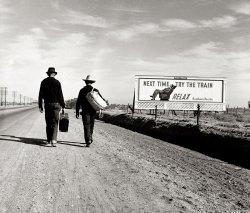
MAY CONTAIN NUTS

Search Shorpy
SHORPY ART

Framed or unframed, desk size to sofa size, printed by us in Arizona and Alabama since 2007. Explore now.
Join and Share
Ad-Free Shorpy
Shorpy is funded by you. Patreon contributors get an ad-free experience.
Learn more.

Recent comments
- Baldwin 62303
- Baldwin VO-1000
- Cold
- No expense spared
- Tough Guys
- Lost in Toyland
- And without gloves
- If I were a blindfolded time traveler
- Smoke Consumer Also Cooks
- Oh that stove!
- Possibly still there?
- What?!?
- $100 Reward
- Freeze Frame
- Texas Flyer wanted
- Just a Year Too Soon
- WWII -- Replacing men with women at the railroad crossing.
- Yes, Icing
- You kids drive me nuts!
- NOT An Easy Job
- I wonder
- Just add window boxes
- Icing Platform?
- Indiana Harbor Belt abides
- Freezing haze
- Corrections (for those who care)
- C&NW at Nelson
- Fallen Flags
- A dangerous job made worse
- Water Stop
Member Photos
The Shorpy
Print Emporium
Print Emporium
Search Shorpy
Search results -- 30 results per page
- Illinois Central: 1942
- ... for Goodman's self-titled 1971 album), describing a train ride from Chicago to New Orleans on the Illinois Central Railroad's "City ... Memphis.
https://www.amtrak.com/city-of-new-orleans-train
(The Gallery, Chicago, Jack Delano, Railroads) ... Posted by Dave - 01/31/2024 - 4:09pm -
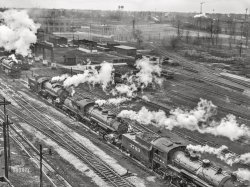
- Cat Patrol: 1942
- ... ears. As good a tracker as she was, I was never able to train her to retrieve.
Shotgun from the Past Looks like a very old E. ... Posted by Dave - 01/05/2024 - 5:37pm -
![Cat Patrol: 1942 November 1942. "Pittsburgh, Pennsylvania (vicinity). Montour No. 4 mine of the Pittsburgh Coal Company. Assistant superintendent getting ready for a hunting trip." Medium format acetate negative by John Collier for the Office of War Information. View full size.
Yes pleaseLike fanhead, I'm all about that fabulous chair. What a work of art. The kitty ain't bad either but I prefer tuxedo cats.
Fair dealI would trade the shotgun for that gorgeous chair. And I'll throw in the cat.
Great trainerI would prefer to take a dog.
A hammer double.Heirloom material.
Having that talk with his cat.https://www.barnesandnoble.com/w/how-to-talk-to-your-cat-about-gun-safet...
Hunting catsWhen the cat, Mary Ann, currently sleeping at my side was younger, she and her sister would accompany me when I would go out on our property deer hunting. One evening, I was sitting on a log and noticed the cat sitting in front of me was staring and her ears were pointed. I raised my rifle and spotted a buck about 40 yards away. At the shot, the deer ran and Mary Ann ran after it. It went into a thicket of briars and I had to work my way in. When I got there, Mary Ann was sitting on the deer's neck, swatting and biting its ears. As good a tracker as she was, I was never able to train her to retrieve.
Shotgun from the PastLooks like a very old E. Remington & Sons 12 Gauge.
[He's also packing a Mouser. - Dave]
The vibeof 1600's Dutch painting.
"Lifter"As subsailor says it's probably a Remington shotgun, a "lifter" design like the Remington-Whitmore. It looks like cleaning and oiling time (which I'm not sure I'd do in such nice clothes)
Shoots & FleasTeaching a cat to use a shotgun can lead to nothing but trouble.
Montour No. 4!I used to live over the hill from that mine and its mining town, known both as Lawrence and Hill's Station, which is likely where this picture was taken. The mine ran under my house is a leafy Pittsburgh suburb, and operated until it was flooded by a breakthrough from the adjacent, closed Montour #10. The rail line that swung like an arc south of Pittsburgh connecting the Pittsburgh Consolidation Coal Company's mines is now a popular rail trail.
(The Gallery, Cats, John Collier, Pittsburgh)](https://www.shorpy.com/files/images/SHORPY-8d09543a.thumbnail.jpg)
- Coming Through: 1905
- ... View full size.
Romanticized View of the Syracuse Train A slightly different postcard view.
Chugging This is wild. It's one thing to see a big train going through a town on a regular, graded right of way, but this is ... Posted by Dave - 08/14/2012 - 2:10pm -
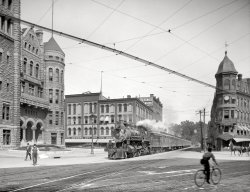
- Copper Hopper: 1942
- ... [That "cart" is a fifty-ton railcar. It goes back on the train tracks after being emptied. - Dave]
NOW I see the railcar still in ... have couplers which can swivel so that a car still in a train can also be emptied, one car at a time.
Impressions Progress First ... Posted by Dave - 11/30/2023 - 2:29pm -
![Copper Hopper: 1942 September 1942. Deer Lodge County, Montana. "Anaconda smelter, Anaconda Copper Mining Company. Cars containing 50 tons of copper ore are dumped by an unloading mechanism into a 200-ton hopper." Acetate negative by Russell Lee, Office of War Information. View full size.
Waste notI've never seen such sight. What happened to the cart that rolled into that chamber on those tracks? Did it just roll off the tracks down into oblivion along with its load of copper? And look at the flimsy housing they built around such a powerful impressive machine. Strange.
[That "cart" is a fifty-ton railcar. It goes back on the train tracks after being emptied. - Dave]
NOW I see the railcar still in there. I didn't realize I was looking at the back of the railcar. I thought it was just the back of the chamber. ¯\_(ツ)_/¯
STAND BACK!That is one nasty pinch-point.
The car on the tracksis actually still on the rails. The mechanism which rolls the car over clamps the car and the tracks together, and as soon as the car is empty, it rolls on over so that the car can be rolled out of that area. This is same way that coal cars are emptied at electric power plants. In most cases the cars have couplers which can swivel so that a car still in a train can also be emptied, one car at a time.
Impressions ProgressFirst - What are we looking at?
Second - Ok, now we get what's going on.
Third - Still scary.
(The Gallery, Mining, Railroads, Russell Lee)](https://www.shorpy.com/files/images/SHORPY-8d08614u.thumbnail.jpg)
- Train Wreck: 1922
- ... the east and westbound freights met in an open switch. The train crews had hardly jumped to the ground when the heavily loaded freight ... and emergency telephone connections established with the train dispatcher's office at Baltimore.
Passenger Trains Diverted.
... Posted by Dave - 09/04/2012 - 11:11pm -
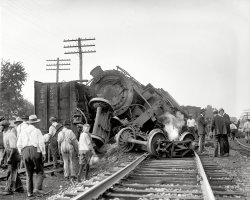
- Road Train: 1918
- ... is Now let's see him parallel park it.
More than a train Ahead of its time: electric traction and air brakes on every wheel; ... Posted by Dave - 06/10/2016 - 11:12am -
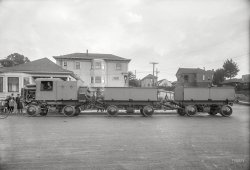
- Vanishing Point: 1943
- ... I wonder if Delano shot from the back of a moving train.
Jack strikes again! Another great photo from the The Man!
On ... Topeka and the Santa Fe.
Not from a moving train Based on the telephone pole spacing, there is a maximum of 500 feet ... Posted by Dave - 12/15/2013 - 12:32pm -
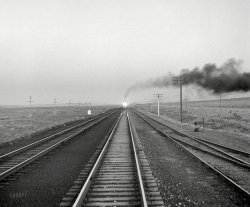
- New Train: 1911
- ... Co. Photographer unknown. View full size.
New Train: 1911 Tighter information: new locomotive (a "train" is what it pulls). O&CRR No. 11, a 2-8-0 Consolidation type of ... Posted by kevhum - 09/23/2011 - 12:02am -
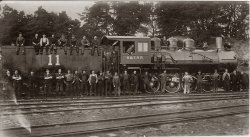
- Prisoners of War: 1864
- ... over this picture since it showed so much detail.
Train Car Check out the train car that is labeled "Hospital Car." I wonder what the interior looked ... Posted by Dave - 11/05/2008 - 10:08pm -
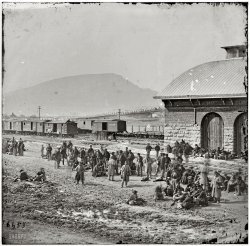
- Train Waving: 1967
- My two younger brothers and myself waving at the train which passed by twice a day on the track across the road from our ... would be appreciated! View full size.
Did a Lot of Train Waving But it was back in the early-fifties when I was about the age ... Posted by AllenTenn - 02/08/2013 - 8:51pm -
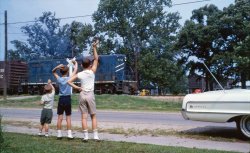
- Blue Train: 1942
- December 1942. Train going over the hump at the Chicago & North Western Proviso Yard. ... 4x5 Kodachrome transparency by Jack Delano.
Blue Train I grew up in earshot of the Proviso Yard Hump. Even took a photo of it ... Posted by Dave - 07/30/2012 - 10:04pm -
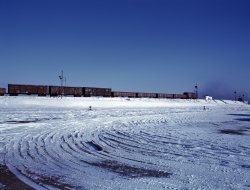
- Base Station: 1906
- ... the incline, I imagine all seats were facing uphill.
Train configuration The train on the right is setup passenger car, engine, passenger car, engine, etc. ... Posted by Dave - 06/18/2015 - 10:58am -
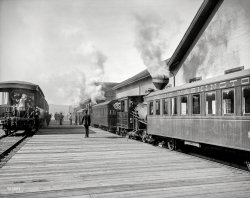
- Nats-Giants: 1924
- ... the next day, October 11. - Dave]
The Big Train Finally Wins This is the game that Walter Johnson, at age 36, pitches ... Nationals' first (and last) World Series win.
The Big Train His house is still located out in Rockville which, in 1924, was far ... Posted by Dave - 09/11/2011 - 11:29am -
![Nats-Giants: 1924 October 10, 1924. Griffith Stadium in Washington, D.C. "Peckinpaugh sees final World Series game from dugout on account of injuries." View full size.
Isn't it the Senators?The old American League Washington Senators became the Twins and have nothing to do with the current Washington Nationals.
[The team was called the Nationals because Washington is the national capital. In 1924, hardly anyone called them the Senators. Below: Washington Post front page from the next day, October 11. - Dave]
The Big Train Finally WinsThis is the game that Walter Johnson, at age 36, pitches the final four shutout innings to nail down his and the Nationals' first (and last) World Series win.
The Big TrainHis house is still located out in Rockville which, in 1924, was far from downtown D.C. and just a small village. The NIH wasn't yet a dream, but would be just a mile away later. Contrast this photo with a modern dugout design! Makes Camden Yards look palatial!
Old MemoriesI had forgotten the Senators being called the Nationals until I saw this. I grew up in Baltimore, home of the Orioles, and the local sports reports often included the Senators results probably because the radio broadcast area reached Prince Georges County where many federal workers lived.
What a change the stadiums have seen in 80-odd years!
Johnson's motionI love the picture. I can smell the sweat and chewing tobacco wafting through the humid early October, D.C. air.
I was looking to see if Walter Johnson was visible. He threw a submarine side-arm pitch which caught people off guard because of the deceptive velocity. I believe that Ty Cobb took advantage of Johnson's fear of maiming a batter, and purposely crowded the plate after a full count. Ken Burn's "Baseball" has a nice segment about Johnson and provides rare footage of his pitching style.
Nats-Giants: 1924Having been a diehard and frustrated Washington Senators fan for most of my first 30 years, I find it oddly appropriate that their only World Championship was won in the seventh game on a bad-hop single in the bottom of the twelfth inning.
Click.Notice the Graflex Super D on the top step of the dugout.
Roger PRoger Peckinpaugh was well regarded in his day, frequently a captain of his ballclub. In fact, at age 23, he managed the New York Yankees for a brief spell.
However, the Nationals probably wished ol' Peck was in an overcoat 12 months after this picture was taken, and not playing shortstop.
Even though he was the American League's Most Valuable Player in 1925, he butchered the 1925 World Series against the Pittsburgh Pirates with some awful fielding. He committed a peck of errors.
Still and all, he spent a lifetime in the game and rose to executive officer with his hometown Cleveland Indians. He enjoyed an interesting career and lived until his 80's.
A hatted worldThis is hardly a new observation, but I can't help but be struck by the fact that every head one can make out in this photo is crowned. Nowhere does it seem to stand out more than in old photos of baseball stadium crowds - photos of people enjoying what most of us in today's world would consider an occasion that calls for very casual attire. What does this say about us, and about prior generations?
Walter JohnsonI actually have quite a few photos of Walter Johnson with my grandfather, who was a big fan. Shorpy, any interest?
Hanging in my foyer is a front page newspaper photo of him with Johnson, Goose Goslin and a few other players - he gave a free suit to any player who hit home runs (my grandfather owned a popular downtown men's clothing store).
For years I have been searching for a photo of Griffith stadium that included a view of my grandfather's ad that was hung in the stadium ... I have been through the LOC website and the MLK reading room with only one very poor result ... anyone have any other suggestions for me?
[It would help if we knew his name or the name of his store. - Dave]
Fred PelzmanFor Jennifer:
Click here (National Photo) or here (Harris & Ewing) and use the top box to search for "baseball." Then click the "Preview images" button to see the thumbnails.
There are dozens of articles and ads related to your grandfather in the Washington Post archive. Which you can probably search from your public library's website (look for "ProQuest Historical Newspapers") if you have a library card. Below are some examples from 1901, 1915, 1932 and 1948.
WJ continuedFred Pelzman's Fashion Shop ... I can send you images of some of the ads with his logo, if that would be helpful - Jennifer
Thank you!Hey Dave:
Thanks so much! I actually have collected a lot of the the materials from the WPost archives (via the library website, bless them for this resource!) - put together a scapbook for my father's 80th birthday last year. FYI, the top two ads here are from my great-grandfather's store (Schwartz & Pelzman) while the others are from my grandfather's - the latter was the big baseball fan. I will forward to you a few of the Walter Johnson photos in case any of your DC baseball fans might be interested.
Thanks so much for the recommendations, as a fourth-generation Washingtonian, this blog is such a huge treat!!!
Explaining "Nationals"The franchise officially changed its name from Senators to Nationals in 1905 because of a horrifically bad year in 1904. It was this name change that the new Nationals were referring to with the logos that say "Washington Nationals: Established 1905." I'm sure the fact that this name change occurred exactly 100 years before the Expos moved to D.C. inspired this.
Anyway, although the team was officially called the Nationals, many people still called them the "Senators" as an unofficial nickname. Since the team only had a "W" on their uniform, who could tell? It wasn't until Clark Griffith died and Calvin took over that the team officially became the Senators and began putting that team name on the front of their uniforms. It's because the team was called the "NATionalS" for so long that people still referred to the "SeNATorS" as "Nats." "Senators" fans in Harrisburg and Ottawa refer to their teams as the "Sens."
They don't look happy - - - yet.If the date is correct, this is the only day in history when a Washington team won the World Series -- despite the decidedly glum looks on virtually everyone in view. The game went 12 innings, and was won when the Giants committed two errors in the 12th. It was also the least-attended game in the series, with only 31,667 paid attendance, about 2,600 short of the previous game and over 35K for the first two games. Odd that there is no festive bunting in sight.
Roger Peckinpaugh was the shortstop for the Washington Nationals from 1922 through 1926, winning the MVP in 1925. He committed eight errors in the '25 Series, apparently still a major league record. His salary in 1924, by the way, was $10,000.
(The Gallery, D.C., Natl Photo, Sports)](https://www.shorpy.com/files/images/26164u.thumbnail.jpg)
- Superstack: 1942
- ... be there).
The stack stands alone The smelter and train tracks and hustle and bustle are gone. The impressive smokestack is left ... Posted by Dave - 11/28/2023 - 3:09pm -
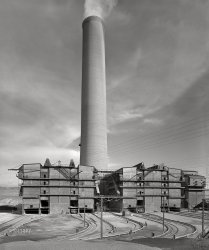
- Little Falls: 1941
- ... of South Ann Street. While the cigar store and the ... train station? ... are gone, along with everything between, Little Falls ... Posted by Dave - 12/05/2023 - 3:42pm -
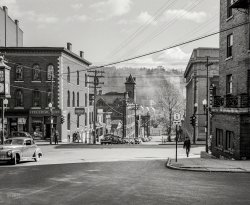
- Little Country Doctor: 1951
- ... and models of all of them: B-17, -24, -25, -29.
Windup Train Received a similar windup train the Christmas before my 4th birthday. Walked up to the train while it ... Posted by Dave - 12/22/2012 - 11:04pm -
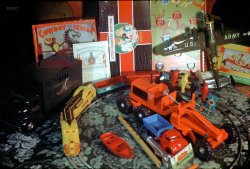
- Extra Starch: 1940
- ... Administration. View full size.
Starch factory or train depot? Despite what the caption says for this photo, the structure ... word "CARIBOU" on the side sure looks to me like an old train depot. The tracks aren't showing, of course, so hard to tell. Maybe it is ... Posted by Dave - 05/17/2016 - 12:48pm -
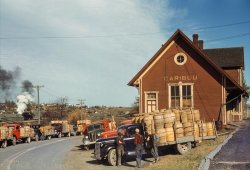
- Log Train Running: 1941
- July 1941. "Logging train. Spalding Junction, Nez Perce County, Idaho." Medium format acetate ... Posted by Dave - 02/08/2022 - 4:52pm -
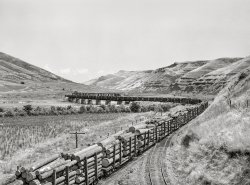
- Christmas Story: 1953
- ... Tom experiencing the thrill of his first Lionel electric train. My Uncle Bill is manning the transformer, and my dad, who was a ... enough to take pictures of anybody with our electric train, only pictures of it, like this one from December 1954. I think it's ... Posted by der_bingle - 12/09/2008 - 6:58pm -
![Christmas Story: 1953 Christmas 1953. Oak Park, Illinois. My cousin Tom experiencing the thrill of his first Lionel electric train. My Uncle Bill is manning the transformer, and my dad, who was a real-life railroad engineer, is on the right. 35mm slide. View full size.
There's a tree somewhereUnder all that tinsel!
SparksWow! I can practically smell the ozone. This could have been me, except we didn't have sense enough to take pictures of anybody with our electric train, only pictures of it, like this one from December 1954. I think it's Lionel, I forget.
This was the time of my life.I might as well be in this picture. The timeline and all that is going on is perfect. Wonderful family shot. WOW! what great memories. Thank you and Merry Christmas to you and your family.
Tinsel HazardsHere's a question for you Boomers -- I see that tinsel was big in your growing up years (understatement). Did people keep their pets outside then, or did they all just die horrible, tinsel-blockage induced deaths? (I know that it doesn't always cause serious problems for them -- but with the sheer amount of tinsel on these trees, it seems like the chances for intestinal problems would be good.)
tterrace, I really like the attractively arranged couch pillows behind your train. What were you hiding back there? Or are they simulated mountains?
Who's having the most funI was so glad when our son was old enough (1957)for me to buy the thing I'd always wanted for Christmas but, because I was a girl, never got. Unfortunately, he was still at the push-toy stage so it didn't work for him but I had a ball.
Re: Tinsel hazardsWhy would pets be eating tinsel in the first place? None of ours ever touched the stuff. I grew up in the tinsel-lovin' Fifties. Dogs and cats eating tinsel was not anything people ever talked about happening. Sounds like some sort of 21st century consumer worrywart issue.
TinselitisI don't know ... because it's shiny and stringy and fun to play with? My cat would go crazy for the stuff, as would most cats I've owned. Maybe even the pets were perfect in the 50s. It was just a question.
[It was an excellent tinsel question. Speaking of which: Garlands or icicles? We were always a garland family. Not that there's anything wrong with icicles. - Dave]
Simulated mountainsVery good, Catherine. I usually have to explain to people what the pillows are doing behind my toys in a number of my photos from back then. These we had retained from our old chesterfield which had been relegated to a slow, moldering death in the basement a couple years back. If you could look above them, you'd see my mother's renowned curtains and drapes.
We never used tinsel ourselves, but I remember enjoying it when we'd visit friends or relatives who did. Those were the days when tinsel was made of, or mostly of, lead. I liked to slip strands off and ball them up into little wads or, better yet, if there were lighted candles around and nobody was watching, dangle them in the flame and watch them melt. Don't tell anybody.
Twin tops?It appears that someone improvised and used some of the TinkerToy pieces to make stands for the 'billboard' signs.
It also looks like the Tinkertoy was also a present that may have been wrapped in aluminum foil. And, there appear to be two identical toys in the picture, possibly spinning tops.
Great picture!
TransformerLooks like the transformer is a Lionel model 1033 (made from 1948-'56). I have one of these units, still in perfect working condition. As far as I know, the only maintenance it ever had was the replacement of the power cord, due to the insulation drying out and cracking (a common problem). I never cease to be amazed at how durable those old Lionels are. Great picture!
LionelI agree, it's probably a Lionel in tterrace's photo. I had an American Flyer I received for Christmas in 1948. American Flyer did not have the middle rail in the track.
A way of lifeAs they say, a way of life gone with the wind.
I love this blog . . .It is threads like this that keep me hooked on this blog. It's comforting to know I'm not the only whack job walking around unattended.
Foy
Las Vegas
Cat TinselWithout the prompting of previous posters I wouldn't have mentioned that during the Christmas season at our house our Siamese cat Tabetha would walk around with a piece of what she usually left in her litter box instead dangling from a piece of tinsel she had once presumably eaten. That's the most tasteful way I can explain it.
Now That's Christmas!Real Tinker Toys, the "real" old-school Lionel train sets, and not those modern knockoffs made by a company that simply owns the name. What do kids get today? Lead lined Chinese plastic "toys" from Wal-Mart.
Boy, give me that old fashioned Christmas anytime.
Thanks, and Merry Christmas to you. My Dad and Uncle have passed on, but Tom - who's now in his sixties - still has that Lionel train set. Last time I was at his house he had it set up in his basement, along with several accessories he's accumulated over the years.
[We're all glad he finally got to play with it! And thanks for this wonderful photo. - Dave]
Chestnuts roasting on an open plasmaThis picture just radiates warmth and good cheer. We're leaving it up all night on our plasma display. It's better than a fireplace!
California TinselI have to think our state banned tinsel production due to environmental concerns, because it's virtually nowhere to be found.
I say "virtually," because Michael's has it. No tinsel at the dollar stores and such. At Michael's it is in packages that need to be cut. The tinsel comes attached at the top. Same stuff.
Thanks to Michael's, our tree looks like this one.
[I think its scarcity might be due more to child-safety concerns. - Dave]
Nothing to add.I have nothing to add. Just love this picture and reading all your comments -- the wallpaper is killer. Shorpy forever.
How we tinseledAround our house, we would always begin with laboriously stringing one strand of tinsel at a time on a barren branch until it was somewhat filled. Yet invariably, we two boys would get rambunctious and throw a handful up where we couldn't reach. And Mom, patient Mom, would sigh and give us permission to begin the fusillade of tinsel throwing that produced a Christmas tree neatly stranded with tinsel about 3 feet up, but above that utter disorder that only little boys could love. But I hasten to add the "tidy line" rose as we grew. Making a much happier mom.
The Train Don't Stop Here No MoreMy Dad had a huge 60's-70's Lionel train set, with all the accessories: the lighted passenger cars, the little signal box with the trainman who would come out, holding his lantern when a train went by, and even the Giraffe Car. Anyone remember the Giraffe Car?
Several locos too, both steam and diesel, and that big control transformer with the power supply handles on both ends. The whole setup ran on a plywood table, about 6 x 8, which he built himself. Sadly, when he died, my mother sold the whole outfit for a hundred bucks, and today it would probably be worth ten times that much. I wish I still had it!
Tinsel informationTo RoverDaddy who is looking for tinsel, try the cheap, cheap, cheap stores. I found it at Dollar General Store but also Family Dollar Store, Dollar Tree and other bargain centers are most likely to have it. You can see I am the last of the big spenders and I have to add that one time when my mother was removing tinsel to save it for the next year, my father asked her, with a straight face, if she was going to make tinsel soup, as she always stretched the life out of a dollar by making lots of soups and stews.
Voices from the kitchenLove this photo! While the menfolk are intent on the train, I can hear Grandma and the aunts in the kitchen talking over each other while getting Christmas dinner ready. Is the turkey done? Did you hear about Great Aunt Stella? She's already wrecked that brand new beautiful car. Mom, that's enough gravy for an army! Did Bill get you that brooch you've been wanting, Madge? And, naturally they're all wearing dresses, heels and festive aprons. This photo is CLASSIC.
Lead-foil tinselThe tinsel on a tree of this vintage is probably made of lead foil. The good news is that it was reusable year after year. The bad news is that you could get lead poisoning from ingesting it!
Lead foil tinsel has long since been removed from the market, along with several other dangerous items from Christmases past!
See: http://www.familychristmasonline.com/trees/ornaments/dangerous/dangerous...
Kids AgainI love this photo because the uncle and the dad are suddenly about 9 years old too.
Windows 53Love those window blinds.
All our cats have eaten tinsel. It makes the litter box more festive. We use both kinds -- short hunks of garland and the stringy silver "icicle" stuff. I too heave the stuff at the tree rather than place it carefully.
Dave, I think Anonymous at 11:25 was talking about the train in tterrace's photo.
[You are so smart. Thank you! - Dave]
Wow.Well this brings along even more memories. I was born in '65 and I remember playing with a train like this in '68 or '69. I do not remember what brand (Lionel or American Flyer), but I do remember putting in a pill pushing a button or something and it would smoke when I pushed it. I remember pissing Daddy off because every time the train would go in front of the TV while he was watching it, I would push that button! Talk about pushing Daddy's button!!! I also remember throwing tinsel on the tree, Daddy helping, and Mom getting upset with both of us. In addition, we also had those bubble lights. After they warmed up they would start bubbling. I need to go lie down and look at Shorpy some more and see what else I can remember.
Too much tinsel...My mother would always complain that my father and I put too much tinsel on our trees. And our beloved Cocker Spaniel, Sherman loved the taste of tinsel.
Xmas ExpressOur house had a very similar Christmas morning about 25 years later. My dad found a second train in a garage he was tearing down. I got them out last Christmas and they still run. I put a video on our site.
RetinselingYup, we did the tinsel thing too, but we were thrifty New Englanders, and my mother took at least some of the stuff OFF the tree every year and carefully put it on cardboard to use it again the following year. My grandmother, bless her, had the job of untangling the resulting mess and handing each of us little handfuls to drape over the branches one by one. Needless to say, we weren't allowed to throw it because then it couldn't be taken off.
All That to be an Engineer????I can't tell you how envious I am of your father.
When I was in the ninth grade one of my teachers decided to play guidance counselor and advise me on what courses to take in high school. She asked what I wanted to be and I told her I would like to be an engineer. She told me I should take Algebra II, Calculus, Physics, etc etc etc.
I sat there in stunned amazement thinking, "All that just to drive a train????" When it dawned on me that we were talking about two entirely different things I was too embarrassed to correct her.
Where can I find tinsel?This year I'd love to introduce my kids to the fun of cheap old shiny plastic tinsel (yes I'm a masochist for wanting to clean up the mess later). Unfortunately, I can't seem to find the stuff anywhere! Does anybody still make plastic 'icicles' as the package often called them, or have they been made extinct by concerns over fire hazards and unfortunate pets?
Retinseling 2And I thought my family was the only one who did this, except we didn't put it on cardboard. All the tinsel went into a cardboard shoe box, year after year. We would add maybe one package of new tinsel every couple of years. The new tinsel would hang straight while the old would be more and more crinkly over the years. My sister & I had to put it on one strand at a time (except when Mom wasn't looking). Being from the Depression era as my mother was, I'm sure that box of tinsel is still up in the attic to this day. Our cat also loved the taste of tinsel, with predicable results.
Lionel 027It's 027, the less expensive Lionel product compared to big heavy "O". Same gauge, lower rail, slightly sharper curves, simpler switches. We had a mixture of both, purchased used from various sources, and we figured out ways to use the 2 sizes together.
That switch is a manual 027 one, with no lighted position indicator, we had a pair of them. Didn't make the satisfying "clack" sound that the "O" manual switches did when you threw the lever. We never had remote control switches, since you could buy more manual ones for the same money.
Some "O" gauge equipment couldn't operate on 027, the curves were too sharp.
Made a serious mistake about 30 years ago, sold all of it except a couple special cars.
Smokin'!My own American Flyer set of that era had tablets that, when dropped into the locomotive's smokestack, would emit little puffs of real smoke.
Gift itI gave my 1948 3/16 model American Flyer to my grandson last Christmas. Much better than selling.
Alas ...In 1954, just after we moved into our spiffy suburban ranch house, my uncle started a large 8 x 16 Lionel O-gauge layout in the basement. Presumably for me, or so he said.
After everyone died off, I inherited the six large boxes of trains and all the fixin's. Fifteen years ago I sold the lot for $450 to a dealer. Dumb move.
But revenge is sweet as I have just started construction on a huge (roughly 100 x 150) garden train layout behind the house.
The RugWhat really caught my eye is that rug -- a dead ringer for one we had for many years! My dad got it at Barker Brothers in 1943. The hopper car and caboose also look exactly like the ones from my Lionel train set from the late '50s, though the rest is different.
I just wanted you to knowI just wanted you to know that you brought a tear to the eye of this grumpy old man, remembering the exact same scene from his childhood.
Thank you.
You made my day, GrumpyGlad this evoked a fond memory for you, as well as for so many others.
Another tinsel commentGrowing up in the later 50s and 60s, we also did tinsel every year. Like many others, we would save it from year to year until it was too crinkled to hang right. Then we'd have to get one or two new packages, probably from Woolworth's or "the drugstore" since Target and Walmart were not born yet. We kids also tossed it up to the top of the tree. These days, I want to get some but my wife says no - you can't recycle it with the tree, she says. Too messy. Too bad. I did see some this year at Target, except the 'new' tinsel has that prismatic glimmer to it where it reflects like a rainbow, not like regular silver stuff. I'll kep trying.
Tinsel and SnowLike Older than Yoda, I can remember taking the (metal foil) tinsel, which we always called icicles, off the tree and saving it. As soon as the plasticky stuff came out, that was the end of that. Another long-gone Christmas memory was a box of mica chips of that Mama would sprinkle on the cotton batting at the base of the tree. That box lasted years and years. When you had parents that came up during the Depression, you learned about saving. My dad: "Turn off some of these lights, this place looks like a hotel!"
American Flyer, no LionelGreat picture ... we all laid our heads on the track and watched the train coming right at us. This is actually an American Flyer 3 rail O gauge train. It was made before WWII. After the war American Flyer went to 3/16" to the foot S-gauge two rail track.
[If it's not a Lionel, why does it say LIONEL LINES on the tender? - Dave]
We used tinsel alsoThat brings back memories. We would go to the woods and cut the "cedar" tree. My family had a flocking machine, and several households on the street would put their tree up the same day, so the flocking machine would only have to be used once per year. We also used to take a strand of tinsel, wedge it in between our front teeth, and blow. I don't know why that was so much fun but it was.
A (real) Christmas storyMy brothers (who were 18 and 9 years older than me) made me a train set for my 5th or 6th Christmas -- I walked into the garage while they were painting the board and I asked if I could help and they told me they were painting a sign and I could help paint it green. When I got it Christmas morning I was the most surprised boy in the world. It was a great gift that I helped make without knowing!
Disney train setWhen I was 5 (back in 1970), my parents bought me a Disneyland Monorail train set. My father had it already assembled for me on a large piece of plywood that had been covered in green fake grass, and had miniature buildings to go with it. Considering what that original set would be worth today, I almost wish he had just left it sealed in the box. All that I have remaining from the original set is the 12v-18v transformer.
Maker of lead foil tinselI'm not sure if anyone is still looking for lead foil tinsel - the stuff some of us fondly remember from our childhood.
It's available from Riffelmacher and Weinberger in Germany. Or rather it's shown in their wholesale catalogue. See p 50 of their 2010 Christmas catalogue, Item 91152 is silver ... exactly what we all remember!
Now your only challenge may be ordering in bulk from Germany.
I can smell the coal smoke from the furnaceGreat picture. I love how the kid's old man gets to run the locomotive, his Uncle is playing Conductor and the kid gets to be Switchman! Gotta pay your dues kid! Looks like they just setout the hopper and tank car and are about to back the engine to re-couple onto the NYC gondola and caboose. A very similar scene played out in many households of the era. I like the Hamilton or Gruen wristwatches that the guys are wearing too.
My cousin Tom, the boy in the photo...turned 68 this year. Sobering perspective on just how long ago this was!
Your photo and story for magazine articleHi, I am senior editor at Classic Toy Trains. We would be interested in publishing this vintage color photo and learning more about the background .
Please contact me at:
Roger Carp
262-796-8776 ext. 253
rcarp@classictoytrains.com
Thanks,
Roger
(ShorpyBlog, Member Gallery, Christmas, Kids)](https://www.shorpy.com/files/images/Christmas-Story-1953_0.thumbnail.jpg)
- Peas Train: 1942
- Sept. 1942. "Special train carrying agricultural workers to upper New York state to work in the ... go Tuesday, accompanied by their families, on a special train chartered by the Farm Security Administration.
Recruited from the ... to maintain, bulletins were frequently issued asking train personnel to watch for, and prohibit, the use of seats as footrests, as ... Posted by Dave - 01/01/2023 - 4:45pm -
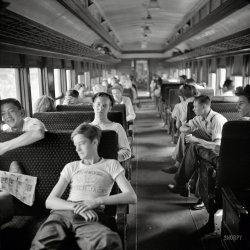
- Death Avenue: 1910
- ... side of the street, about in line with the front of the train, there is a woman holding something white. Can someone with a better ... large would be carried--unless maybe it was scared by the train?) or squirming child, or possibly a massive sack of flour (not that ... Posted by Dave - 08/10/2012 - 4:16pm -
![Death Avenue: 1910 A detailed circa 1910 Manhattan streetscape of rail cars at West 26th Street and Eleventh Avenue, known as "Death Avenue" for the many pedestrians killed along the New York Central's freight line there. View full size. Removal of the street-level tracks commenced on December 31, 1929. 5x7 glass negative, George Grantham Bain Collection. Update: Click here for the largest version.
A Freight TrolleyI think this is one of my favorite photos ever. There's so much going on here that is representative of the time that I could spend hours scrutinizing it. I'd never even heard of there being freight trolleys that would rumble down city streets (I know, I need to do my homework). All the activity and storefronts and normalcy of it all. Simply incredible.
"How do I get to the Susquehanna Hat Company?"
Re: Freight TrolleyHere's a closeup of the engine. The coal seems to be in a bin on the front. Bain took several photos of this rail line and the freight cars. I'll post some more in the coming days. Any railfans out there who can tell us more about the 11th Avenue line?
What's she holding?Out of all the details in this picture, there is one that has drawn my attention. On the left side of the street, about in line with the front of the train, there is a woman holding something white. Can someone with a better monitor tell what that is? I'm thinking large dog (though I think it's unlikely that a dog that large would be carried--unless maybe it was scared by the train?) or squirming child, or possibly a massive sack of flour (not that likely, I admit.)
Anyone?
[Looks like a bundle of packages wrapped in paper. - Dave]
Freight Trolley?I don't think so, at least not by most definitions. A trolley draws power from overhead lines and I can't see any power lines above the tracks or the necessary connecting wires (and their poles) to keep it in place. I do see a steam engine [Coal-powered. See photo below. - Dave] of a fairly specialized type and in the distant background a line of freight cars crossing the street. Given the proximity of the location to the Hudson River (it's near what is now Chelsea Docks) it wouldn't surprise me if this wasn't a New York Central spur line to connect the docks to a main line, in the period before most of the rail traffic in New York City went underground. There is a street car in the shot, but I'm guessing that it's a horse car (pulled by at least one horse).
What I find really interesting is that there's not a motor vehicle in sight, just horses, and the sheer amount of what the horses left behind (to put it euphemistically).
"Freight Trolley"The engine, as noted below, is clearly not a trolley. It appears to be a "steam dummy," a small locomotive, largely enclosed, often looking like a streetcar so as not to frighten the horses. A conventional locomotive, even a small one, with large driving wheels and flashing connecting rods, would certainly frighten the animals.
Mounted FlagmanI guess the guy on the horse on the foreground is also a mounted flagman... he is preceding the steam train to protect pedestrians!
Remember... "2000 killed in ten years" on the Death Avenue (Eleventh avenue)!
-----------------------------------------
Funimag, the web magazine about Funiculars
http://www.funimag.com
Funimag Blog
http://www.funimag.com/photoblog/
Guy on the roofDid you see the guy on the top of the roof of the third wagon? I am wondering what he is doing! Maybe watching pedestrians!!!
Incontinent horse!Did you see the incontinent horse?!!! Gash...! What a big river!!! That picture is really fantastic!!
Re: Guy on the RoofThe man on the roof is a brakeman. Riding a car roof is better than hanging on a ladder on the car side.
Horse-drawn tramJust to the right (our view) of the "train" is a horse drawn tram car being drawn along the track in the opposite direction.
BrakemanPlease note that there are no brake hoses on the locomotive. All handbrakes, so the brakeman rides on top because the staff brakes are on the car tops. to stop the train the engineer signals the brakeman and he starts ratcheting down the handbrakes
How fast?I'm wondering just how fast these trains were barreling through the street to hit so many people? If they were being preceded by a guy on horseback they couldn't have been gong all that fast. And yet people still did not notice them coming? How does one not hear a steam locomotive?
Tank DummyPerhaps the locomotive is one of these (scroll down to
the bottom of the page):
http://www.northeast.railfan.net/steam22.html
The sheer amount of detail in this is incredible.E.g. the kids' chalk scrawls on the sidewalk.
I'd imagine that a lot of the deaths occurred at night or in bad weather.
My favorite partMy favorite part is the kid running down the sidewalk on the lower left. Perhaps he's trying to outrun the train? He reminds me of the drawings of Little Nemo.
[Lower left? Or right? - Dave]
The beer wagonIncredible photo! The detail is fantastic. I like the beer wagon (wishful thinking?) in front of the train. I am just amazed....
CrutchesWhat about the guy on crutches on the right. I wonder what the story is behind that.
26th and 11thI went and looked up the intersection on Google maps, and the whole right side is a parking lot now.
Triangle Shirtwaist FireThe worst factory fire in the history of New York City occurred on March 25, 1911, in the Asch building, where the Triangle Shirtwaist Company occupied the top three of ten floors. Five hundred women, mostly Jewish immigrants between thirteen and twenty-three years old, were employed there. The owners had locked the doors leading to the exits to keep the women at their sewing machines. In less than fifteen minutes, 146 women died. The event galvanized support for increased safety in the workplace. It also garnered support for labor unions in the garment district, and in particular for the International Ladies' Garment Workers' Union.
Much material was provided by several websites, but two in particular I want to call attention to, the first for an overall exceptionally presented look back at this tragedy and a stunning presentation of the labor movement. Truly a brilliant multimedia presentation.
The Triangle Factory Fire – Presented by The Kheel Center, Catherwood Library, ILR School at Cornell University.
and National Public Radio ...
I can not recommend those two sites too highly. They are top-notch.
And on YouTube, The Cloth Inferno.
11th Avenue TrainBeneath the "dummy" shroud, it's actually a two-truck Shay locomotive, a type of geared power popular on many logging and industrial operations with sharp curves and steep grades.
High LineThis rail line was replaced with an elevated line that entered the warehouses of the west side on their upper floors. It continued to be used into the early 1980s mostly for boxcars of produce. The boxcars shown are refrigerated for perishable items. The roof hatches are for loading ice into bunkers at the ends of the cars.
The elevated rail line still exists but is now owned by the city which is rebuilding it into an elevated linear park in Manhattan's Chelsea district.
11th Ave trainIf you look at the largest version you can see that it says 11 on the front which would make this an 0-6-0, class B-11. The Shays also show the offset boiler. Great photo.
26th and 11thWest 26th & 11th is the location the fabulous old Starrett Lehigh Building, a block-long warehouse looking like a stylized ocean liner, with train tracks from the pier leading right into the building and up the freight elevators. Its time was past before it was even finished in 1931 as the trucking industry eclipsed rail freight. Funky old place to wander around if you ever get the chance.
26th & 11thThe right side of 11th Ave & 26th St will be the terminus of the 7 Train extension from Times Square. (last station will be 11th Ave and 34th) . They are currently boring down to the bedrock.
NY Central dummy engine>> Beneath the "dummy" shroud, it's actually a two-truck Shay locomotive
It seems the NY Central Shays weren't built until 1923-- so looks like he's right about the engine being an 0-6-0 beneath the dummy housing.
N.Y. Central ShayA city ordinance required that a horseman precede the rail movement, and that the locomotive be covered to look like a trolley car so as not to frighten horses. When the line was elevated it was electrified, I believe with locomotives that could also run on batteries to access trackage that had no overheard wires. At that time the Shay locomotives were put to use elsewhere on the New York Central system. Here is a photo, from my father's collection, of one of the Shays in service near Rochester, I believe. The spout on the left is not part of the locomotive but is on a water stand behind it.
Not The Sound of Silence!Just try and imagine the sounds here! The shod horses clomping down the brick street. The wagons creaking along as the wheels roll on the bricks and dirt. The various bells (church, train, etc) pealing, the subtle sounds of conversations and pedestrian footsteps, the whisk of broom bristles as the street is cleaned! Much preferable to the honking, boom-boxing, brake-screeching, muffler-rapping scenarios we endure today!
10th AvenueAnother pic shows what 11th Avenue north from 26th St actually looked like; someone mislabelled this negative of 10th Ave.
Building Still ThereAccording to a post here, this is actually the intersection of 10th Ave and W 26th Street. I looked up this intersection on Google Maps and it appears that one of the buildings in the old photo is still there. It's way down the street..behind the train, the 3rd building from the end on the left side of the street. (The windows look like there is a white stripe connecting them). I think that is the same building on the northwest corner of the intersection of 10th Ave and 27th Street. Just thought I'd throw that out there :)
29th StLooks like you're right, that bldg is still there, but it's on the NW corner of 29th St and 10th Ave. In the Google streetview it's about a twin of the bldg at 28th St.
At the left edge of the Shorpy pic you see 267 10th Ave, which means the engine is about to cross 26th St. The train moved from the yard onto 10th Ave at 30th St.
Pic of 11th Avenue https://www.shorpy.com/node/12859
(The Gallery, G.G. Bain, Horses, NYC, Railroads)](https://www.shorpy.com/files/images/02882u1.thumbnail.jpg)
- The Rest Is History: 1914
- ... But where is Gromit? He can explain everything.
Drive Train I'm still not sure of this device's intended purpose, but based on the ... derailing. Perhaps it is (also) meant to run in front of a train to clear heavy snow off locomotive tracks.
[It would have nothing ... Posted by Dave - 03/27/2022 - 1:10am -
![The Rest Is History: 1914 "Man, possibly William B. Greene, with model for a machine that appears to be designed to scoop up material." Circa 1914-1918, an inventor and invention that scarcely need introducing to anyone born in the 20th century. Harris & Ewing glass negative. View full size.
It's either
It's either inspired by monkeys at the zoo, or some form of travelling fan. Such a fan might be used in orchards on cold nights, to stop a frost settling on the fruit.
But, I'm going with the monkey device.
Back to the drawing board"1914. George Ferris's famously unsuccessful first attempt at a carnival ride."
Salt Water TaffyI agree it's a taffy puller by Peter or a peter puller by Taffy.
I know what it is ...It's a waterway power generator. An advanced form of the old-fashioned waterwheel.
Obviously.
Unless it's a power ice cream scoop.
ContraptionThe machine could never be an excavator since the buckets are located in line with the wheels. Also, because of the chain arrangement, the buckets would never tilt over to dump anything. A friend of mine who has a M. E. degree says it must have been some sort of windmill. Be nice if someone could run down the patent application. At the time of this photograph, it was not necessary to have a model of an invention with the exception of those for perpetual motion machines. Maybe as has been suggested, it was intended for removing bats from mine tunnel roofs?
[No one said it was an excavator. We said it's the conveyor that follows the excavator. If the buckets were full and not in dump mode they'd be facing up, side by side. - Dave]
Well of course.It's the prototype of the machine that would eventually add two scoops of raisins to Raisin Bran. This one could do two boxes at once.
How longare you going to keep us guessing? It's slowly driving me crazy!
You can build this!My first thought was an early Erector Set.
Another way of looking at it
What it isObviously (or maybe not) this is some sort of mining conveyor designed to travel on a track in the tunnel behind the excavator. The buckets are shown here in the dump position. The electric motor would be for demonstration purposes.
[I think you're on the right track. So to speak. The archive caption for these is "unidentified machine model." - Dave]
Wensleydale ExcavatorQuite clearly a young Wallace. But where is Gromit? He can explain everything.
Drive TrainI'm still not sure of this device's intended purpose, but based on the two images, I'm pretty sure this is how it operated. Perhaps with this sketch, someone might be able to come up with the intended application.
The sketch shows the chains and sprockets in bold and the electric motor at left. The "buckets" on the end of each arm are kept synchronized in the shown position relative to the floor based on the evidence supplied by the second photo. Only one of the two arms is shown in this sketch and the "phantom" arm is provided only to show the synchronized orientation of the "buckets" as the arm rotates. The chain was intentionally disconnected in the first photo so that the arm could be manually rotated to show the construction details. The second photo show both arm aligned parallel with each other. The relationship of the buckets with respect to the floor could be varied depending on how both "bucket" sprockets were initially aligned with their sprockets on the drive shaft. Based on the small number of teeth on the motor sprocket, this was a low-speed device (less than 100 RPM). My guess is that this is a working model that was submitted along with the patent application.
Scoop?With the open sides of the buckets it doesn't seem that it would be a very efficient scooper of anything unless that which it was scooping was larger than the openings. I can't imagine what that would be. For that matter, I can't imagine what this is.
Maybe we need to think larger scale. Perhaps this is a small scale model of what is intended to be a much larger contraption. If the sides of the buckets were closed it could scoop just about anything. I think the key here is the two sets of buckets on either side. Maybe this was for a farm for digging rows for planting. Maybe it was an early ditch witch for burying power lines - a hot and a neutral.
[I'd say our 3:36 commenter pretty much nailed it. - Dave]
I am the energizer bunny of waiting DaveI think Dave has gotten our expectations too high, and now he will not be able to deliver.
To say that anyone born in the 20th century will instantly go "oohhh...so that's who/what he/it is" may be a promise he can't keep.
Universal recognition of a piece of mining equipment, and by anyone born during anytime of a whole century?
No, sad to say, I think Dave realizes his mistake, and is delaying, hoping to wait and tire us out.
But I will be here Dave...waiting...waiting...waiting.
[Did we not read all the comments? The answer, such as it is, is down below. - Dave]
Dave cracks me upIts his witty comments that make the difference as we ply around in the dark trying to figure out some goofy photo. Its Dave who makes it such fun. What a goof!
Well of course.It's a taffy stretcher. Am I warm?
Car.It's simply an automobile that moves by pushing air.
The scoops are obviously less practical than propellers, but perhaps the idea of a propeller wasn't as obvious then as now. Or the inventor was just dumb.
That's Peabody, famous in West VirginiaExperimental model of a dragline or bucket conveyor.
SprocketsI've got no idea what this is, but it's never going to work as long as the crucial middle chain remains off the sprocket.
If the inventor spent less time looking fiercely proud, in his obviously used-to-ridicule way, and more time hanging all his chains, we'd have guessed what this is by now.
Not Scoops or ScrapersEach pair of hoppers is facing in the same direction at all times, as controlled by the chain drives when the central shaft rotates. So it can't be intended to operate as a set of scoops for wind or water, or scrapers, or conveyor buckets. This inconvenient arrangement shot down my pet theory that the device was intended to clear roosting bats from the ceilings of railroad tunnels.
Generator, tooI see it as a generator, too, but a hydro-electric one. Small scale, for use in a stream, or at a small waterfall. Wheels just for display purposes?
CannibalizationI dunno what it is, but Mrs. Inventor is going to be plenty ticked off when she finds out what's happened to their baby carriage, bicycle and coal scuttles.
SnowplowIt's a early electric snowplow. Not only did the electric cord do it in, but it didn't have anything attached to it to knock over roadside mailboxes or pile up snow at their driveway entrances.
A flying machineThe scoops take up air at a constant aspect angle as they rotate.
My guessA generator, perhaps wind-driven.
Obviously"Harry Reese's early attempt at making machinery for use in combining and cupping chocolate with peanut butter."
If it was intended for useIf it was intended for use in a mine, it wasn't well designed. That motor would not last more than a day or two if that in the dust of a mine. All those friction points would be dangerous in a gaseous mine environment. And if it's a miniaturized model, full size it would be too big to operate in the tight confines of a mine.
Maybe it was a prototype that never went into production.
[As noted below, the motor would be for demonstration purposes. As for "friction points," just about any coal conveyor would have had zillions.- Dave]
You may laugh now......But just wait 'til you wake up to see an army of those things marching down your street!
Following in Grandpa's Footsteps...It's Eli Whitney the Fifth, and his Patented Gin Cottoner
Medical technology setback"This well-intentioned but ill-conceived invention thwarted doctors' attempts to encourage regular colonoscopies for almost fifty years."
Sound effectsIt's clearly a "clip-clop" sound effects machine for the movies. Unfortunately, the inventor failed to realize that talkies were still several years away.
Congressional Sanitation DevicePrototype device, designed to patrol the Congressinal aisles, scooping up massive amounts of government waste and depositing it in a trailing container for recycling. The practical Dual Scoop System permits it to work both sides of the aisle. A fleet of them were subsequently manufactured and work diligently to this day.
Road Apple CleanupThis is a nice Electric Rolling Pooper Scooper.
This inventor would have been a household name but for the phasing out of horse-drawn carriages.
WowNicest apple peeler I've ever seen.
Please, introduce us!Well, yeah, gee that thing sure does look familiar, I had one in my backyard growing up, but even then I wasn't sure if it was to rock the baby or pick the corn or thresh the wheat. I'm sure I'll slap my forehead and feel real dumb when you tell us, but what the heck is that, if not a ferris wheel with finger-removing gearwheels?
It's a KlugeAs the story goes, a Navy captain wanted to know every man aboard his ship and what they did. All went well until one sailor came before the Captain, gave his name, rank, and serial number followed by "Kluge maker, first class."
After some discussion among the officers, the Captain said he would certainly like to see a kluge in action. The young swabbie said he would demonstrate the next day. And sure enough, at noon sharp the sailor wheeled an ungainly object to the rail, and threw it overboard.
As it hit the surface it went "Kluge."
Obviously this is a prototype kluge.
Another Fine Acme ProductNew! Acme Little Giant Spilz-All (Pat. Pend).
Despite the helpful drawing, I'm still mystified by the orientation of the hoppers, since the very simple gearing and chain drives appear to keep them rotating to preserve the same angle (i.e. dumping only, as shown) through the full rotation around the main horizontal shaft. UNLESS the gear on each hopper is actually rotating it 360 degrees as it circles the shaft. Even with a fixed rate of rotation there might be a point in the rotational cycle in which a hopper is on the horizontal to receive loose material from one source and then, as it rises and turns, dump it onto a receiving conveyor positioned at a higher level. The device might then function as a sort of elevator from one conveyor to the next. But this still seems pretty whack, since the usual way of doing this is by ramping pairs of conveyor belts one above the other. This device may be so mysterious because the inventor offered a solution to a non-existent problem, and it never got beyond the demonstration model stage.
Holy bucketsThe "buckets" can't be for holding anything because they are open at the sides.
Maybe the "working" side of the bucket is the outside. Perhaps it's an automated skein for winding yarn or some other textile manufacturing process.
[The buckets in this coal or ore conveyor would be closed in a working example. The near end of the bottom left bucket shows how it would look. - Dave]
Maybe & Maybe NotSome seemed convinced that this is a coal or ore conveyor designed to ride behind a coal car, but I'm not convinced. If it was meant for that task, wouldn't the scooping buckets clear a wider path than just over the rails? This design would account for a lot of waste. If that is what it is, then perhaps that is why the design failed, but I don't think so.
Since it is only scooping over the rails, perhaps it was designed to ride in front of the cars and was meant to clear debris off the rails to keep the cars from derailing. Perhaps it is (also) meant to run in front of a train to clear heavy snow off locomotive tracks.
[It would have nothing to do with railroads or trains. The conveyor travels on a track behind the excavating machine in an underground mine to get the coal or ore out of the tunnel, moving its cargo both horizontally and vertically. Or it might move along a track in an open-pit mine. Whatever it is, it looks mining-related. Designed for carrying and dumping. - Dave]
Ok I don't want to give up...Thank you for this one, it has been one of the most entertaining posts I have witnessed. You need to do more mystery objects/people often.
Ok but...This will be my last comment because I'm obviously not understanding the explanation that you seem so sure of.
There is a large gap between the 2 buckets. If this is the design then it would only scoop coal or ore off the two sides and leave a large gap in the center. Unless I'm missing something - which is always a possibility - that does not make sense.
[I think you are confusing the excavator (the machine that does the mining) with the conveyor. Which conveys -- i.e. it is designed for carrying and dumping. Not scooping. - Dave]
Ummm, no.You're grasping at straws.
[Below, an electrically powered excavator. The coal is carried to the left along the conveyor belt on top and dumped or dropped or shoveled into coal cars or buckets, which are on a track. - Dave]
Beating a dead horseNo, I'm not confusing anything about the terminology. This "conveyor" that you are imagining this thing to be, if it runs behind the excavator, as you claim, only conveys material that is sitting on top of the rails. There is a huge gap between the rails that is left untouched. Nothing is conveyed between the rails. This is the issue I have with the explanation being given.
[The excavator fills the buckets of the conveyor from above. The coal is not "sitting on top of the rails." - Dave]
Re: Ummm, no.Yikes. Nightmares!
Sing along now...It went "zip" when it moved
and "pop" when it stopped
and "whirrr" when is stood still
I never knew just what it was
and I guess I never will
What's the nameof the inventor?
[We don't know. At least not yet. - Dave]
The buckets always face the same waySo it must be a seed spreader. (A person pushes the device along and the seeds spill out of the openings in the side of the buckets as the buckets move gently up and down.)
Barber-GreeneIt's a bucket loader, invented by Harry H. Barber and William B. Greene. I don't know which of the two is the guy in the picture.
[I think you're onto something. Among Barber-Greene's early products were a coal conveyor and a mobile bucket loader for use in cement plants. Who are you and how'd you figure this out? - Dave]
Founding Barber-Greene
Barber-Greene was founded in 1916 by Harry Barber and William Greene, co-workers at Stephens-Adamson, a conveyor company. Interested in embarking on a business venture of their own, the two became partners – Barber would handle product design, while Greene would be in charge of finance and business administration. The partners were interested in mechanizing small jobs "out of the shovel and wheelbarrow stage."
The First Conveyor Orders
Initially, Barber and Greene operated their new company from a makeshift office in a guest room at the Barbers’ residence. They subcontracted W.S. Frazier and Co. of Aurora, Ill., to manufacture the products Barber-Greene designed. In October 1916, the partners established credit with General Electric, and ordered the supplies they would need to make their first conveyor, the "No. 1," in the Frazier workshop. Before long, the company had received an order from Lilley Coal Co. With the profits made from this order, the partners began advertising in the Retail Coalman, a Chicago-based publication. As a result, the company began to receive multiple orders, and began to grow.
Harry H. Barber, William B. Greene
(The Gallery, Curiosities, Harris + Ewing)](https://www.shorpy.com/files/images/08196a.thumbnail.jpg)
- The Pulpit: 1899
- ... This is a good picture of that being done.
Special Train? The engine is a Chicago & North Western S-2 class 4-6-0 built in ... looking out from behind the car suggesting a very special train. Perhaps top management. Perhaps an inspection train. The locomotive is a ... Posted by Dave - 07/13/2015 - 2:29pm -
![The Pulpit: 1899 Circa 1899. "Near Lewiston, Minnesota -- The Pulpit." Yet another rock formation with a fanciful name. 8x10 inch dry plate glass negative. View full size.
Link and Pin CouplerThat locomotive is equipped with a primitive Link and Pin coupler. You can see a link hanging from the pin, plain as can be. This is a dangerous manual coupling system that exposed RR workers to dismemberment and death.
There is no air brake hose visible, either.
The 1893 railroad safety appliance act made automatic couplers and air brakes mandatory. It was phased in over seven years, so the actual date of the photo is most likely before 1899 and certainly is not after 1900.
Karst TopographyI'd like to have a look in that cave on the right.
Does anyone know if the Pulpit still exists?
Filling in a trestle.It was common practice when these rail lines were built to erect trestles over low places and when the line was completed and in service go back and fill in around the trestle. This is a good picture of that being done.
Special Train?The engine is a Chicago & North Western S-2 class 4-6-0 built in 1890. As such it was an example of the biggest and best the railroad had before 1900. The engine lasted until 1925 when it was scrapped. In this photo it hauls one passenger car--an attendant appears looking out from behind the car suggesting a very special train. Perhaps top management. Perhaps an inspection train. The locomotive is a good deal more powerful than needed for one passenger car--an ornate at that.
Special Train followup. Responding to SouthBendModel34--The Chicago & North Western (C&NW)line through Lewiston I believe started life as the Winona & St. Peter Railroad which had a close association with the C&NW. Note the C&NW logo on the front of the smoke box of number 148. Construction was started about 1866 and the C&NW purchased the railroad in about 1867 though it operated it as a separate entity until 1900. The railroads shared motive power designs and classification codes though motive power , numbering and logos on locomotives were kept separate until the final merger.
Locomotive 118The number plate at the center of the locomotive smokebox seems to read 118.
The line through Lewiston MN is currently the Dakota, Minnesota & Eastern, which is a successor to the Chicago and Northwestern Railway. (Which may or may not have constructed this line: can any Shorpy Sleuth come up with a construction date for the RR through Lewiston MN?
The trestle fill-in would probably be not too long after the opening of the line.
Can photo enhancement read a RR name on the side of the tender, or the name of the single passenger car? (Which is probably the RR's Business Car. This looks like an inspection trip to check on the progress of the trestle fill.)
There's curved, raised lettering on the locomotive smokebox which I would guess to be the name of the locomotive. builder. Can that be enhanced ?
[Signs on the tender and car aren't legible. -tterrace]
PulpitThe cave on the right is a legend about it being the Devil's Hole. (see photo)
[The photo you attached related to the Lewiston in New York state, not Minnesota. -tterrace]
[Thanks. Being a Brit, I don't know my NY from my MN...]
C&NW Business car 104The open platform car was leased (owned?) by the Detroit Photographic Company.
(The Gallery, DPC, Railroads)](https://www.shorpy.com/files/images/SHORPY-4a04037a.thumbnail.jpg)
- Shop Early for Xmas: 1922
- ... us, I've posted a bigger closeup here .
Lionel Train Set That Lionel Electric Train Set is to die for!! I know fellow collectors who, if they had only the ... Posted by Dave - 11/06/2015 - 12:35am -
![Shop Early for Xmas: 1922 Washington, D.C., circa 1922. "Sport Mart, 1303 F Street N.W." Shorpy would like one of each, please. National Photo Company glass negative. View full size. Update: For the window-shoppers among us, I've posted a bigger closeup here.
Lionel Train SetThat Lionel Electric Train Set is to die for!! I know fellow collectors who, if they had only the original box displayed in this picture, would be in fandom heaven. Joshua Lionel Owen invented the first toy trains in 1901 so New York City Department Stores could use them for window displays during Christmas. The rest as they say is history. Great picture. Also, just can't imagine any store having all those guns in a front window anymore, with just plate glass in front of them as protection from theft. Were people really that honest back then?
Don't bother with the girlsLove all the signs. Also interesting to see another pre-WWII swastika, and this one is even turned 45 degrees onto a point, the same as the Nazis did.
[That's two interlocking S's, for Stetson Shoes. Ten lines. A swastika has six. - Dave]
Airguns $1I'm sorry, Shorpy, you don't want that. You'll put your eye out.
Western Auto, Carroll Cut Rite....In the small mill town where I grew up, we had the two stores mentioned as well as United Cigar and Hart's 5 & 10. Their windows examples of just about every single item in inventory. The multitude of tiered shelves allowed one to see what was inside without actually going in. For the kids (like me) that had a total of $10 to buy six gifts, it was great to stand in front of the window and budget out the allotment, figuring out who would get what before actually buying. Mom always got the blue bomb bottle of Evening in Paris or dusting powder, Dad got something in Old Spice, an inflatable toy for my baby brother, handkerchiefs or an autograph book for Sis, etc. Christmas will never be as meaningful as when we had to budget every cent because it really meant something more than just purchasing merchandise.
I'll take the...Kodak Autographics, bike and Lionel train sets, please!
Santa Please......bring me the sled that looks just like Rosebud, and the Lionel trains, and the golf set with those fabulous hickory shafts. I need a new niblick.
Alice MaynardOne wonders what Alice Maynard is selling "upstairs." Probably entirely innocent - probably ladies clothing based on what we can see in the second floor windows - but the filthy mind gets all sorts of ideas.
Can I have the .22 please?That Winchester pump .22 would be worth big bucks if it were in good condition today.
Re: Santa Please...I couldn't help but notice the fatness of the "pre-pass" era type of footballs. More like a rugby or Aussie rules football.
Toy StoryGreat photo, Dave. I can't tell how much the chess set is, but it looks like a nice one. Cowboy suede holsters and Indian feathered headbands would be frowned upon today. I am puzzled why a thermos is more expensive than a golf set. There's so much to look at. By the way, are those irons (the kind for pressing clothes?) What's with that?
[The sign under the vacuum bottles is for a $15 "tackle outfit." - Dave]
I have a pump .22 a lot like the one in the window......but its a "Savage" vs. a "Winchester", octagonal barrel, you can take it apart with one screw. Last fired about 25 years ago!
Not to Nitpickbut it's Joshua Lionel Cowen, ne Cohen. He was the great-uncle of the infamous Roy Cohn, who later was board chairman of the train company.
Fix bayonets!That Daisy BB gun has a bayonet on it -- more fun than lawn darts!
SavageI believe Savage was taken over by Winchester way back when. I had a 1918 Winchester pump as a kid. I really loved it and used it in the late 40's and 50's. Wish I could find another under $1k.
Aw, Why do I have to be a girl?I'm looking at all the really neat stuff in the window. All my friends were boys when I was growing up and their toys were the best. If I lived back then, my mother would have shopped for me one door over to the right, where they have a selection of ugly, boring dolls.
Dreaming of the train set...
.38How long would those pistols last in a glass storefront in 2008? Not long.
Pistols..The pistol on the right is most likely a Colt Model 1903 .32 ACP or perhaps a Model 1908 .380. The Revolver is a Smith and Wesson. I can't identify caliber size or frame type. As to the pistol on the left, your guess is as good as mine.
It's interesting that Washington D.C. in the 1920's where you could buy guns no questions asked at a department store with glass windows was much safer than 21st century D.C. where possession of any one of the firearms in that window was a felony until recently.
What every boys wants...but should he get a revolver?
Oooooh! Oooooh!I was born 25 years later, but in spirit my nose- and handprints are all over that Sport Mart window. I have hundreds of engines and cars in my collection but no Lionel that goes back to the 1920s, much to my sorrow. Dad couldn't wait to put one under the tree, so I had my first one at age 4; at 62 I still play with trains! (Sadly, electric train sales have fallen on hard times and only the old boys are interested.) I do have most of the cameras in that window but they aren't quite so shiny -- but they do work, even the ones going back to the 1870s.
Air rifles weren't allowed in my family (had to play with my friend's guns on the sly) and they sure couldn't be had for a dollar then!
Even the boys in my family spent a lot of quality time using an iron (the ones that put a crease in your britches and made your starched shirts crisp -- not the ones you hit little white balls with) but I don't remember thinking it was much of a sport! Note that the golf balls there are individually wrapped. I don't recognize the bike in the window, but it looks big; in the early 1950s we had a hand-me-down of indeterminate origin, the only 38-incher in the neighborhood.
Not much in the window for the little girls in 1921. The signs seem to indicate they may not have gotten them personally as gifts, but in some families the "tomboys" had their ways! Some things have changed for the better.
A Visit from the Innuendo FairyDon't all "bicycles" have "reputations?" Nudge, nudge, wink, wink, say no more!
ShockingBesides the toys there are bunches of household items on display (but don't get me wrong, I want the train set and a basement to put it in). I'm suddenly interested in the parallel history of the battery and portable electrical devices. Things like flashlights had to have been introduced for the consumer with a battery in mind. Of course after a few years batteries became ubiquitous, but imagine going to a store and picking up a battery and not already owning anything to put it in.
Lionel for ChristmasI had a circa 1941 Lionel freight train complete with all the cars and a headlight. I got it for Christmas. It also had little tablets that you could drop down the stack so that the engine puffed smoke as it tore around the three-rail track. Alas, my dear mom gave it away to Goodwill one day when I was in high school. Sigh!
Indoor SportsSome of the Christmas Specials in this display window bring new meaning to the term Sporting Goods. The lower left section is filled with electric-powered household appliances: Irons, a toaster, a coffee percolator ("perculator" in the sign) and a set of antler-handled carving knives for that Christmas turkey. When I was a kid in the 1950s there were a few moms in our neighborhood who seemed to think that Extreme Ironing was a competition sport, but they usually got their gear at Sears. And what about that accordion in the back row next to the electric space heater?
$16There's a sign just below the sled for $16 but I can't make it out. Can you blow it up?
[Kaboom. - Dave]
Electric TorchJust to feed everyone's new interest in the subject, here's a post from the inimitable Daniel Rutter that includes some early flashlight background.
$5.50 for a dozen golf balls.A lost ball in a water hazard or the rough had to have hurt!
Made In U. S. A.For an advocate of American-made goods which are currently difficult (to impossible) to find for gift-giving, I assume that almost everything in this window was made right here in the USA. A twinge of sorrow takes over as I wonder if Lionel is still made here, or Daisy Air guns or Flexible Flyers. Christmas lights shown here for $8.50 (a huge amount of money in 1921) can be bought today for a couple of dollars. Yes, imports are cheap, cheap, cheap, but also disposable and short-lived. Time marches on and even Levis are made in Mexico, Converse in China. I did find nail clippers made in the USA last week for $1. Maybe I'll be like Jack Benny and give gifts of just shoelaces and nail clippers this year. Don't know of ANY toys or electronics made here. One other non-imported gift suggestion is to give the gift recipient a hand-made gift card for FOUR HOURS of personal advice. (few people will cash it in) Merry Christmas fellow Shorpy addicts.
Get the boy something he wants...All he wants now is a Wii, a Playsatation, a Game Cube, an iPod...
How unfortunate. I want a time machine.
How dare they...Look at them! Creating these restrictive gender roles and explicitly marketing them to impressionable children? The audacity! The horror! Someone call the NOW and shut these advocates of boyhood down!
Rampant (and refreshing) political correctness aside, this is a fabulous picture. I love these, where you can just drink in wonderful little details. You can even read the sign company name on the SportMart sign. You really do a great job sharpening these up, Dave.
What's the white squiggly line in the upper left corner? Looks like the border of a postcard or something, but how did it get in that rather strange location on this picture? Either that, or I'm missing something very obvious and it's a water pipe or something.
[It's the decoration (or alarm tape, which did indeed exist in 1921) on a windowpane. - Dave]
Made in USA.Yoda, I know what you mean, but on the other hand, today when we sub out low end manufacturing, the material wealth is so much higher. Most kids today would already own some or most of the goods in the window display, whereas I bet that the overall market penetration of electric trains, etc. was much more limited in the 1920s.
Is that a Red Ryder BB Gun?Santa sez "You'll shoot your eye out, kid. Merry Christmas! Ho, ho, ho!"
Jean Shepherd must be chortling (yes, chortling, that's what he said) and smiling down on this scene.
Nice gunsGrew up in Rogers, Arkansas where the Daisy plant was located. I had a lever-action '.30-.30' style bb rifle that you loaded from the side - it lasted for years and received all kinds of mistreatment. Also, learned to shoot with my grandfather's .22 that looked quite similar to the one pictured, but I cannot remember what make it was.
Smith & WessonThe 3 pistols in the front center appear to be Smith & Wesson. Their boxes sport the distinctive (intricate) S&W Logo, or an earlier version of it.
Small Pistol on the LeftI realize this is 6 years later, but what the heck. The small pistol on the left in the group of three pistols appears to be either a Mauser 1910 (25ACP) or the 1914 (32 ACP).
(The Gallery, Bicycles, Christmas, D.C., Stores & Markets)](https://www.shorpy.com/files/images/30432u-xmas.thumbnail.jpg)
- Planes, Trains: 1935
- ... and airplanes, the eventual doom of the railroad age."
Train by night, plane by day In 1935, the Pennsylvania Railroad, along with ... would leave New York in the evening, and take an overnight train to Columbus, Ohio where you would board a plane to Wichita, Kansas. At ... Posted by Dave - 02/27/2014 - 10:03am -
![Planes, Trains: 1935 June 12, 1935. "Newark passenger station, Pennsylvania Railroad. Waiting room, sunlight and passengers. McKim, Mead & White, client." Waiting for someone to explain the plane. Large format negative by Gottscho-Schleisner. View full size.
McKim, Mead & WhiteThis question may merely be in consequence of my occasional transient befuddlement, but whose client is McKim, Mead & White?
[The photographic firm of Samuel Gottscho and William Schleisner. -tterrace]
History of transportation"The interior of the main waiting room has medallions illustrating the history of transportation, from wagons to steamships to cars and airplanes, the eventual doom of the railroad age."
Train by night, plane by dayIn 1935, the Pennsylvania Railroad, along with the Santa Fe Railroad out west, had a partnership with TWA. In the early days of commercial air travel, night flying was not yet viewed to be safe, so for a time the railroads would partner with airlines, to offer fastest transcontinental services by taking the trains overnight, and flying during the day. You would leave New York in the evening, and take an overnight train to Columbus, Ohio where you would board a plane to Wichita, Kansas. At Wichita, you would board the Santa Fe for an overnight trip to Clovis, New Mexico, where you would get on another plane to either L.A. or San Francisco.
As Newark Penn Station opened in 1935, I expect that's why there's a plane on the wall.
What's your sign?In addition to the medallions symbolizing the history of transportation on the walls, the hanging lanterns are surrounded with ornamental bands depicting astrological signs; not sure how that ties into the history of transportation.
Excitement not shownAs a kid visiting Newark Station long ago to pick up Grandmother from Cincinnati, it was unbelievably exciting. Huge rumbles from overhead trains coming in, and when you were old enough you got to visit various platforms to be near trains. Those were real trains, with GG-1 locomotives and pullman cars and full service dining cars. Unintelligible public address announcements. It started to go downhill around 1960.
Memories of homeAs a former Newark resident I remember this waiting room quite well. I would pass through there on my way to catch the PATH (Port Authority Trans Hudson) Trains to NYC. Outside the windows on the left there was usually a queue of taxis lined up. Behind the doors below the airplane was an exit that led to loading platforms for buses that went to places like Seaside and Asbury Park.
I left Newark in 1976 but I suspect that the waiting room looks the same today as it did back in 1935.
Times ChangeWhile the structure of the room remains the same, the ambience is somewhat diminished. The benches are usually populated with vagrants. I frequently notice that, as a result, those who are seated are spread out, as no one chooses to sit within five feet or so of the "regulars".
It's a depressing room these days; at least on the weekends, when I pass through. If the situation is better on weekdays, I'd be happy to hear of it.
Still crazy busy, after all these yearsYes, it does look substantially the same today, thanks to an extensive restoration in the 1980's. Newark Penn features four levels of interconnections: Cabs and buses at street level; Tracks 1-5 above, including NJ Transit, Amtrak Regional and Acela service; PATH trains ("The Tubes") at roof level; and a basement-level terminal for multiple light rail lines. As late as the 80's, this last level ran 1940's PCC trolleys... ten cents intra-city in those days. A few abandoned cars were found in a walled-off siding under the street when that siding was returned to service for new light rail service around 2002.
Some ChangesIn front of the windows, where the three lone travelers sit, is now a high-tech snack bar. Incongruous with the lovely deco surroundings. It's not unusual to find sparrows, pigeons, or other flighted friends walking or fluttering about. To their credit, Newark's Finest do their best to keep the waiting room and platforms clear of homeless and panhandlers. Taxis still line up outside, but passengers departing need to walk more than a block from their designated "drop-off" area since 9/11. Progress...
Opening the windowsAnyone know how this was done? I see the hinge apparatus but wondering how opening the high windows was achieved?
Some funky cable cable system? Long poles?
[There's a fitting with what looks like a crank hole near the base of each window. - Dave]
Trains vs. PlanesI don't know why, but I still have to see the airport building or photograph thereof which rings a bell with me anywhere near as much as well-designed well-built train station.
On an airport, the planes are the show, if at all.
Maybe it has to do with much greater accessibility and, say, democratic "feel" of a train station? Or with their general location (middle of town vs. outskirts to boonies)?
re McKim Mead & WhiteWell, to quote Katnip, "that sounds logical".
About that planeSince Newark constructed an airport in 1928, there is a better than average chance that the reference is there. You know, take the train to the station and a cab or bus to the plane. Still done today. Not many trains to planes, even now.
"Airway Limited"Transcontinental Air Transport (New York to Los Angeles (Glendale) in less than 51 hours, train-plane-train-plane) started in summer 1929; one-way fare was $338 including a lower berth each night on the train. By 1935 it was all over-- T&WA DC-2s were scheduled Newark to Glendale? Burbank? in less than 18 hours and the fare was $160.
Train Time!I'm totally amazed that no one has noticed that it's time for the Chattanooga Choo Choo to head South ('bout a quarter to four).
Transportation medallionsIf I recall correctly, there are twelve medallions total. Penn Station Newark is still a place at which you can start a cross-country train journey, and while Amtrak is not as elegant as Pullman cars nor as attractive as GG-1s, it's still comfortable and good food served in the dining cars.
Medallion of "Electric Locomotive"Here's a shot of one of the medallions at the other end of the building.
Let there be light!The original lighting fixtures after being cleaned and refurbished.
MedallionsHere is a more modern view of the interior. Notice the other medallions.
(The Gallery, Gottscho-Schleisner, Railroads)](https://www.shorpy.com/files/images/SHORPY_5a02635u.thumbnail.jpg)
- Maine Train: 1940
- October 1940. "At the railroad terminal in Caribou, Maine." Medium format acetate negative by Jack Delano for the Farm Security Administration. View full size.
The Trains in Maine ... Stay mainly in their lanes?
Can't get theah ... Posted by Dave - 11/01/2022 - 12:27pm -
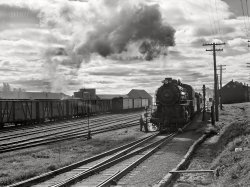
- A Keen Christmas: 1920
- ... below. - Dave]
Full speed ahead I like the model train layout. Someone put a lot of effort into building it. Seems like there are two different kinds of train sets in use. The top one looks like Lionel since the track has three ... Posted by Dave - 08/23/2012 - 11:42am -
![A Keen Christmas: 1920 Washington, D.C., circa 1920. "Mrs. A.M. Keen. Christmas tree." Somewhere in there: a very tiny kitchen sink. Harris & Ewing glass negative. View full size.
19th century iTunesFor those youngsters out there, the case at the far right is filled with piano rolls. Used to have a player piano in our basement when I was a kid, and hundreds of old rolls just like the ones inside the case.
Noah's ArkThe ark with all the animals escaping is really cute and the details on the miniature house is great. Wonder if one person made this or if it was a group effort.
Too badthere are no photos of the previous year's setup. Mrs. Kean recreated the 1919 signing of the Treaty of Versailles in the Hall of Mirrors!
Busy, busy, busyMuch to see and too much to really enjoy but my questions are: how did those girls get to the croquet field, and what's in the boxes inside the glass case?
[Piano rolls, as noted below. - Dave]
Full speed aheadI like the model train layout. Someone put a lot of effort into building it. Seems like there are two different kinds of train sets in use. The top one looks like Lionel since the track has three rails but the bottom one is two rail track for something else, with that neat model of a steeple cab electric locomotive (interesting that someone chose to build a model of one of those in the 1920s).
For years, I wanted to lay out a loop of track around my family's Christmas tree and run my model train on it but my parents shot me down every time. I'm doing it for the first time this year since I'm in my own place now.
"Merry Christmas From the Family"Robert Earl Keen's ancestors, perhaps.
WOW! Elaborate Train SetWith a Charlie Brown tree.
And OverallA grand chandelier!
Santa/SatanThis is the first time I have seen a Christmas ornament depicting the devil. Very odd.
Tree toppersIt's very weird to see the long pointy ornaments that today are saved for the top of the tree, sticking out from various branches.
KrampusThe fellow with the horns is Krampus, Santa's evil counterpart.
In old-school German folklore, Krampus filled out St. Nick's mythic entourage to play bad cop to Santa's good. For those on the naughty list, Krampus got downright medieval. Traditionally depicted with huge horns, a black mane, talon-like claws (Krampus comes from the Old German for "claw"), and wielding chains and a birch rod, Santa's enforcer beat, whipped and shamed bad children. Sometimes, Krampus went so far as to shove his victims into a sack and throw them into a river. He seemed also to have a particular penchant for birching young, pretty virgins. More here.
As seen byThis seems to be Henri Rousseau's model train layout.
Pointy OrnamentsA true artistic talent need not be bound by convention.
Look Up, Way Up!The one thing missing from this image is a friendly giant wearing boots. Bob Homme would have envied this train and homestead scene around the tree. A cow jumping over the moon would not have been out of place with this tree and neither would a castle next door.
Bobble HeadsIt looks to me that both the giraffe and the dog (mountain lion) on the rocks to the right of the giraffe are bobble heads. The heads are balanced on a hook in the neck of the body. Tap the head and watch them wiggle for awhile.
Twinkly!Lookit all the little lights! They're even buried in the dirt in front of the croquet girls. I bet this looked gorgeous at night.
I'm a little mystified by the critters in front of the log cabin, though. Is that a tiny giraffe??
Just wonderingWhere do they put the presents?
Re: Busy, busy, busy«How did those girls get to the croquet field?»
There is a gate in the fence. They would have to cross the tracks, but who wouldn't risk their lives for an exciting game of croquet?
The Hook...and Rear AccessIt looks like the tree is attached to a hook in the ceiling for stability. I wonder if that was a permanent fixture that they used every year?
When that Steeple Cab Electric Locomotive jumps off of the track when it is under the tree (inside the tunnel) how do they retrieve it? It look like there might be access from the rear that is visible in the tunnel that the upper train is exiting. Even so it would be a low clearance to get to the lower set of tracks from behind.
Time stood still"Son, Santa can stop time so that he is able to set up this display." My dad would say, if I asked the big question.
Politically Incorrect, but...We need this Krampus guy today. Too many spoiled and bad boys and girls.
Declasse DecorNice to see that people with bad taste were putting up absurd Christmas decorations 90 years ago. I can just imagine Mrs. Keen showing off this display to her friends, beaming with pride, only to have them poke horrible fun at it behind her back.
I was waitingFor some one like kjottbein to notice the gate. There is also the little tram car (that doesn't seem to be to scale) that could have brought them thru the tunnel from the upper level.
It's fun to look at these old Christmas Gardens and dream.
I feel so bad...that the good Mrs. Keen must have put HOURS and HOURS into this labor of love, and all I can drool over are those gorgeous doors and baseboards.
Greco-Roman Gardens and The DogOf course no authentic period diorama would be complete with nude statutes in the Greco-Roman garden!
And, is that a lonely dog waiting for someone to open the gate at the top of the stairs to the right?
Wonder what happened to all the props from this elaborate diorama. Which thrift store got all these treasures?
Krampus is Oh. So. German.Okay, I don't usually go in for German-bashing since my great-grandmother emigrated from Hanover, but I laughed out loud at the comment about Krampus. (And the link, with its Colbert clip, was hilarious. Next year, I think we'll have to live it up on Krampustag!)
A.M. KeenWith a name like that you'd better be a morning person.
Citizen KeenI think William Randolph Hearst played with this as a boy. How else could he have come up with the idea of San Simeon?
Can't you just smell the Ozone!That steeple cab locomotive running on the lower level is a rare one. Made by the Howard Miniature Lamp Co. of NYC c. 1908. These ran on 2 inch wide track. Just wonder how many other Howard trains are derailed in the tunnel!
(The Gallery, Christmas, D.C., Harris + Ewing)](https://www.shorpy.com/files/images/21786a.thumbnail.jpg)
- Night Train: 1943
- One of our first posts 10 years ago, enlarged and re-restored.
April 1943. "Illinois Central R.R. freight cars in South Water Street terminal, Chicago." Judging by the clock, this was a five-minute time expo ... Posted by Dave - 05/01/2017 - 9:24am -
![Night Train: 1943 One of our first posts 10 years ago, enlarged and re-restored.
April 1943. "Illinois Central R.R. freight cars in South Water Street terminal, Chicago." Judging by the clock, this was a five-minute time exposure. Kodachrome transparency by Jack Delano for the Office of War Information. View full size.
Beautiful :^)
A 5 minuteBeautiful :^)
A 5 minute exposure and this was taken in 1943. Maybe ISO 25 film or lower?
KodachromeAlthough standards for film speed varied [no ASA, no ISO but Kodak, Weston, etc] Kodachrome was what we'd think of as 8 to 10. By the sunny 16 rule that's 1/10 second at f16, so hold really still, and if it's not sunny, hold reeealllly still. It was available, as noted, in 4x5, truly awesome, up to 8x10, and in 35mm and 828. 828 was a paper-backed roll film that was 35mm wide but unperforated, so a larger picture area than a 35mm frame. Thus Kodachromes from the 40s are true treasures - it took lots of light and that meant big multiple flashes [bulbs] or long exposures. The permanence of Kodachrome is why we can see these images now, when other pre-E-6 process images have faded away. Now Kodachrome's time seems to be up, and too bad. When the CDs with digital pics have faded or no machines exist to translate them, Kodachrome images will be good enough to toss on the light table or hold up to the window and enjoy.
Pabst SignPabst beer was the king on the East Coast back then, before Bud's big adverts.
Jack Delano photosThis entire series of photos, including the non-rail, is one of the best things I've ever seen on the internet. Thankyou -all, for posting them!!
Being thereI have never seen so many beautiful photographs from the 1940s that are on your site, thank you. The clarity and colour of the images is remarkable it is just like you are standing there in person it's very surreal.
World's largest sign?Wasn't this the world's largest neon sign at the time? I think my father said it was.
Silly QCan you do long exposures with digital? Is it necessary? Will you get better/higher definition like what we see here?
["Definition" doesn't have anything to do with exposure time. Resolution depends on the number of elements (pixels) in the image sensor. To shoot digital images with resolution comparable to the large-format Kodachromes and glass negatives seen here you could use a studio back like the Sinar 75H (33 megapixel sensor, image size 68 to 260 mb). Which, not coincidentally, is also the equipment used to image these very same Kodachromes and glass negatives. - Dave]
KodachromeThis is the original Kodachrome (the only one made in 4x5 and sheet film sizes) which would be ISO 10 although it was not labeled as such because they didn't have the ISO system then. Kodachrome II was ASA 25 and was released in 1961.
I love these images. I show them to people and when I say it's from 1942 their jaws drop. It just shows you how much we have regressed since then. The fact that no mass produced digital technology can come close to replicating a 79 year old technology is just sad. I'm going to try out 4x5 color printing and I honestly can't wait.
Millennium ParkToday the yard is long gone and this area is now part of Grant Park, with this northwest corner specifically called Millennium Park. Most people have seen photos of the primary exhibit in this part of the park known as Cloud Gate. It is made up of very smooth rounded art shapes with a mirrored surface, and is quite popular not only with kids but also with photographers.
Bit late for the response but...You very much can do long exposures with digital. I'm a photographer myself, and thats one of my favorite 'things' to do.
The reason you'd want a long exposure usually is because high ISO ratings introduce grain and generally degrade in quality. With newer cameras, this is becoming less and less of an issue. The brand I shoot with recently introduced a camera capable of ISO 819,200 which in layman's terms is 'pretty freakin' insane.'
(The Gallery, Kodachromes, Chicago, Jack Delano, Railroads)](https://www.shorpy.com/files/images/SHORPY-1a34791u3.thumbnail.jpg)
- Cripple Creek Short Line: 1901
- ... kind of primitive vibration damping system.
Missed the Train Did those two dressed-up people miss the last train?
Jumbotron The part of the picture, shown below, sort of looks ... Posted by Dave - 07/20/2012 - 1:39pm -
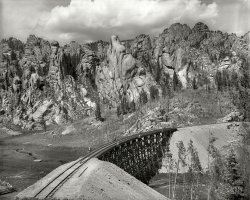
- Try the Train: 1937
- California, March 1937. "Toward Los Angeles." View full size. Medium format nitrate negative by Dorothea Lange for the Farm Security Administration.
Magnificent Now THAT is a photograph. Such powerful social commentary captured in a si ... Posted by Dave - 07/17/2012 - 10:12pm -
